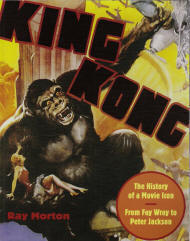Making movies. Enjoying movies. Remembering movies.
|
|
|
|
Related Articles:
|
Posted February 9, 2006 |
|
King Kong: A History Of A Movie Icon—From Fay Wray to Peter Jackson A Book Review |
By
William Kallay

King Kong, both the
original movie and the icon, most certainly has a fan base after all of
these years. Since its release in 1933, the film has the reputation of being
a groundbreaker in regards to the implementation of early sound ingenuity
and visual effects excellence. One of those fans is Ray Morton, a senior
writer for Scr(i)pt magazine, who has written a book called “King Kong: A
History Of A Movie Icon—From Fay Wray to Peter Jackson” (Applause Theatre &
Cinema Books, 2005).
Morton’s book contains information not just on the original “Kong” movie,
but each and every feature film made after it, including “Son Of Kong”
(1933), “Mighty Joe Young” (1949), Japanese-made films with Kong, the 1976
big budget remake, and 1986’s “King Kong Lives” (both from bad movie
virtuoso producer Dino De Laurentiis), and a bit on Peter Jackson’s current
“King Kong” (2005). This is a book with a tremendous amount of historical
detail. Who would’ve thought that reading about the 1976 version of “Kong”
would be so fascinating to read? For fans of the original, they will not be
disappointed in Morton’s step-by-step history of that film’s genesis.
The original “Kong” was perhaps one of the first blockbuster films made.
There were a number of big and expensive films made prior to “Kong” like
“Ben-Hur” and “The Lost World” (both 1925), but no other film combined
action, visual effects, a clever sound design, and a rousing score quite
like “King Kong” did. (Of course, it should be noted, that both “Ben-Hur”
and “The Lost World” were made in the silent era.)
Morton writes about “Kong’s” producer/director, Merian C. Cooper. Cooper
flew combat missions, made early travelogue films, and saw motion picture
innovation come to fruition in the Cinerama format. One could say that “they
don’t make ‘em like they used to.” The author takes special care in
introducing readers to nearly every key person who worked on the film, not
just Cooper. Co-director/co-producer Ernest B. Schoedsack, effects genius
Willis H. O’Brien, actress Fay Wray, actor Robert Armstrong and many others
get some nice “screen time” in Morton’s book. He provides readers with short
backgrounds on them, plus how they became involved in cinematic history’s
big ape movie.
The book is also carefully laid out in chronological order. Each Kong
incarnation is given a short history from script-to-screen, and this is one
of the highlights of the book. For a fan of any of the Kong films, Morton’s
organization is welcome! It’s very obvious that the author took the time to
research the history of each production, no matter how badly some of them
turned out. And it is entertaining to read about the seriousness that went
into a bomb like “King Kong Lives.” It goes to show that despite the best
intentions of people involved with a big production, there is the
possibility that the film can turn out to be a stinker.
Pre-production illustrations, stills and poster art are spread throughout
the book. Even if you’re not a fan of Kong, this book is worthy of purchase.
Readers are shown how certain scenes, whether they were in the films or
never shot, were carefully planned. Of special interest are the sketches by
Willis O’Brien and stills of his stop motion work. Morton’s account of his
underrated, and perhaps under appreciated visual effects work (in its day),
is given full respect and time to be appreciated today. This is fascinating
“stuff.” The cast and crew of the original “Kong” were certainly a part of
movie history, and Morton shines the spotlight on them.
The book is a celebration of nearly all things Kong. I’m admittedly an
appreciator of the original film, but not a huge fan of it. As a kid, I
remember the big hype generated over De Laurentiis’ updated film, ala 1976.
I didn’t see the film until years later on television. I wasn’t too
impressed by it, though the ape and some of the visual effects were well
done. Yet, because of Morton’s meticulous book about the big ape, I started
to appreciate the significance of the original and its offspring. Hit and
miss, most of the films have some value to them. And because of Morton’s
book, I became interested in seeing all of the films (if available on DVD).
I went out and bought the three disc DVD set and have been very glad I did.
In essence, Morton has converted me into a fan of some of the films. Maybe
not on the level of putting up posters or buying Kong 18-inch models, but I
can see why many people today admire, in particular, the original and maybe
even “Mighty Joe Young” (an enjoyable movie). The author has done his Kong
homework. If there was such a place as “The University of Movie Fans,”
Morton would graduate with the highest honors for his thesis on “Kong.”
“King Kong: A History Of A Movie Icon—From Fay Wray to Peter Jackson”
By Ray Morton
Softcover: 349 pages
Applause Theatre & Cinema Books
2005
$19.95
Special thanks to Harrison Ellenshaw
